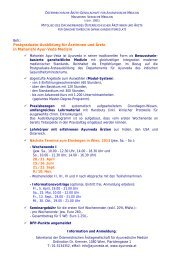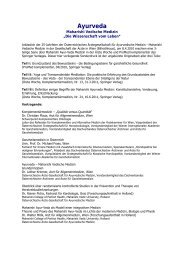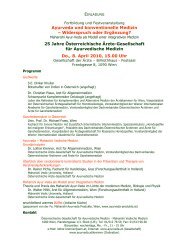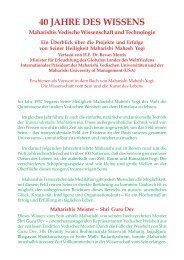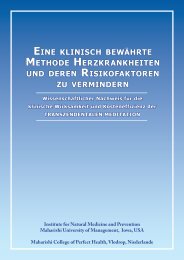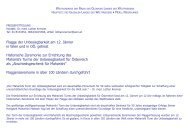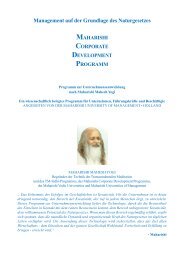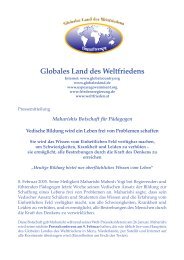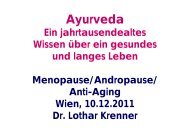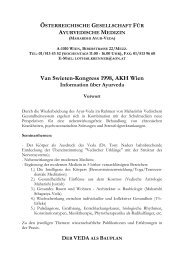Summary of Research Findings
Summary of Research Findings
Summary of Research Findings
You also want an ePaper? Increase the reach of your titles
YUMPU automatically turns print PDFs into web optimized ePapers that Google loves.
Antioxidant <strong>Research</strong> (continued)<br />
18. Title<br />
Oxygen Free Radical (OFR) Scavenging Effects <strong>of</strong> an Anti-Carcinogenic Natural Product, Maharishi Amrit Kalash<br />
Publication<br />
The Pharmacologist, Vol. 32, No. 3, p. 155, 1990 (Abstract).<br />
Authors<br />
Jeremy Z. Fields, Paresh A. Rawal, John F. Hagen, Todd Ing, R. Keith Wallace, Philip F. Tomlinson, and Robert H.<br />
Schneider.<br />
Conducted at<br />
Res. and Med. Svcs., VA Hosp., Hines, IL 60141<br />
Depts. <strong>of</strong> Pharmacol. and Med., Loyola Univ. Med. Sch., Maywood, IL 60153<br />
Dept. <strong>of</strong> Physiology, Maharishi Int’l. Univ., Fairfield, IA 52556<br />
<strong>Summary</strong><br />
Recently H. Sharma et al (Pharm Bioch Behav, 35:767-773, 1990) showed that MAK, an herbal mixture<br />
derived from 15 different plants, prevents and even reverses chemically induced breast tumors in rats. Although<br />
the chemical constituents are not yet known, we hypothesized that MAK might contain one or more scavengers<br />
<strong>of</strong> OFR. Aqueous extracts <strong>of</strong> MAK (5g + 10 ml H 2 0), or superoxide dismutase (SOD), or vehicle were added at<br />
various dilutions to suspensions <strong>of</strong> [1] human neutrophils (PMN; 1 x 10 6 cells) prior to stimulation (by phorbol<br />
myristate acetate) or [2] xanthine/xanthine oxidase. Superoxide (SO) was monitored via reduction <strong>of</strong> ferricytochrome<br />
C followed at 550 nm. Like SOD, MAK was able to completely scavenge SO and MAK did not compromise<br />
the viability (trypan blue exclusion) or respiration (O 2 utilization) <strong>of</strong> PMNs. Thus, the anti-oxidant properties<br />
<strong>of</strong> MAK may contribute to its anti-carcinogenic properties.<br />
Study 18 <strong>Research</strong> Highlights<br />
Aqueous extracts <strong>of</strong> MAK added at various dilutions to suspensions <strong>of</strong> human neutrophils (PMNs) were able<br />
to completely scavenge superoxide and did not compromise the viability or respiration <strong>of</strong> PMNs. Thus, the<br />
anti-oxidant properties <strong>of</strong> MAK may contribute to its anti-carcinogenic properties.<br />
40



